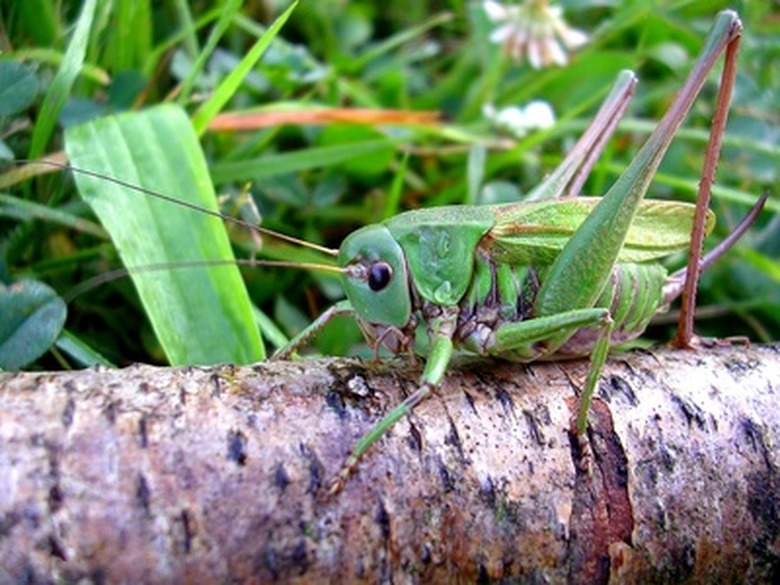How Are Grasshoppers Harmful?
The grasshopper averages 2 inches in length, with six legs, three distinct body parts and two antennae. The two back legs allow the grasshopper to jump up to 30 inches, according to the University of Nebraska, Lincoln Department of Entomology. It sports a pair of wings that give it the ability to travel 30 to 50 miles per day in search of food to feed its voracious appetite. Grasshoppers thrive around the world with 11,000 distinct species.
Density
Grasshoppers pose a threat to vegetation, crops and ornamental plants. Depending upon the year, grasshopper density can reach nine grasshoppers per square yard or climb as high as 60 plus grasshoppers per square yard, according to the Bureau of Land Management. Grasshopper treatment usually becomes necessary if there are15 plus grasshoppers per square yard because the destruction to vegetation can become widespread.
- The grasshopper averages 2 inches in length, with six legs, three distinct body parts and two antennae.
- The two back legs allow the grasshopper to jump up to 30 inches, according to the University of Nebraska, Lincoln Department of Entomology.
High Populations
The grasshopper eats virtually nonstop and can easily consume half their body weight in greenery per day. High populations of grasshoppers, a density that exceeds 30 grasshoppers per square yard, will quickly consume all green plants, wood, vines and even the paint on buildings before moving on to look for more food. Grasshoppers have been known to eat holes in clothing left on clotheslines, according to the Colorado State University Cooperative Extension.
Water and Trains
Widespread infestation of grasshoppers poses a serious risk to water supplies as they invade streams, ponds and wells. The bugs drown and contaminate the water quickly. Grasshoppers landing on train tracks can create a slick, dangerous situation for trains coming down the rails. The trains become significantly delayed in reaching their destinations due to the slower speed that is required to safely traverse the slippery rails through widespread grasshopper invasions.
- The grasshopper eats virtually nonstop and can easily consume half their body weight in greenery per day.
- High populations of grasshoppers, a density that exceeds 30 grasshoppers per square yard, will quickly consume all green plants, wood, vines and even the paint on buildings before moving on to look for more food.
Aftermath
After the land has been rendered barren due to grasshopper foraging, native plant life becomes threatened as noxious weeds begin to invade the area quickly. Soil erosion often develops in areas that have suffered high vegetation loss. Wildlife, such as deer, elk and antelope sufferer when there is no forage remaining to consume.
Control
Nosema locustae, a biological protozoan, offers control when used for small grasshopper populations. Unfortunately, control is often not gained the first year of application but will assist in later years. The preferred chemical control method for large scale grasshopper infestation is diflubenzuron; this insecticide works by destroying the insect's exoskeleton after it molts. Diflubenzuron is non-toxic to all mammals and bird life except aquatic life forms it also does not affect bees.
- After the land has been rendered barren due to grasshopper foraging, native plant life becomes threatened as noxious weeds begin to invade the area quickly.
- The preferred chemical control method for large scale grasshopper infestation is diflubenzuron; this insecticide works by destroying the insect's exoskeleton after it molts.
